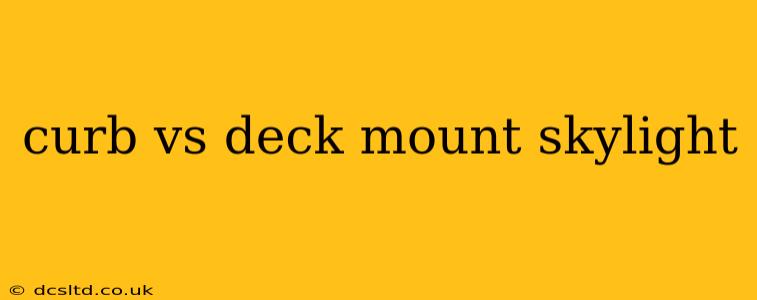Curb vs. Deck Mount Skylights: Choosing the Right Fit for Your Home
Adding a skylight is a fantastic way to brighten your home and connect with the outdoors. However, the installation method significantly impacts the overall aesthetic and functionality. This comprehensive guide will delve into the key differences between curb-mount and deck-mount skylights, helping you make the informed decision that best suits your needs and architectural style.
What is a Curb-Mount Skylight?
A curb-mount skylight, as the name suggests, is installed on a curb – a raised, usually framed structure built into the roof. This curb provides a robust and stable base for the skylight, facilitating easier installation and offering superior weatherproofing.
Advantages of Curb-Mount Skylights:
- Superior Weather Resistance: The curb acts as a significant barrier against water leakage, making these skylights highly suitable for areas with heavy rainfall or snowfall.
- Enhanced Insulation: The space between the curb and the skylight allows for better insulation, contributing to energy efficiency.
- Easier Installation: The raised curb simplifies installation, making the process less complex than with deck-mount skylights.
- Greater Structural Support: The curb provides increased structural support for larger and heavier skylights.
Disadvantages of Curb-Mount Skylights:
- More Expensive: The added cost of constructing the curb contributes to a higher overall installation expense.
- More Intrusive: The curb requires more significant modifications to the roof structure, potentially impacting interior ceiling height.
- Less Aesthetically Versatile: The raised curb might not be compatible with all architectural styles.
What is a Deck-Mount Skylight?
A deck-mount skylight is installed directly onto the roof deck, eliminating the need for a separate curb. This approach often results in a sleeker, more integrated look.
Advantages of Deck-Mount Skylights:
- Sleek and Minimalist Design: Their flush installation provides a cleaner, more modern aesthetic.
- Cost-Effective: The absence of a curb reduces installation costs and material expenses.
- Maintains Ceiling Height: Deck-mounted skylights don't intrude on ceiling height, making them ideal for rooms with lower ceilings.
Disadvantages of Deck-Mount Skylights:
- Increased Risk of Leaks: The lack of a curb increases the chances of water leakage, requiring meticulous installation and high-quality flashing.
- More Complex Installation: Precise installation is critical to prevent leaks and ensure proper sealing, demanding expertise from the installer.
- Limited Size and Weight: Deck-mounted skylights generally accommodate smaller and lighter skylights due to the reduced structural support.
Which Skylight is Right for My Home?
The best choice hinges on several factors:
- Roof Type and Pitch: Steep-sloped roofs are generally better suited for curb-mount skylights, while flatter roofs might be more compatible with deck-mount options.
- Budget: Deck-mount skylights offer a more budget-friendly solution, while curb-mount systems come with a higher price tag.
- Aesthetic Preferences: If a clean, minimalist look is desired, deck-mount skylights are preferable. For superior weatherproofing and insulation, curb-mount skylights are a better option.
- Climate: In areas with harsh weather conditions, the superior weather resistance of curb-mount skylights is a compelling advantage.
How much does a skylight cost?
The cost of a skylight varies considerably based on factors such as size, material (e.g., glass, polycarbonate), features (e.g., electric operation, solar capabilities), and installation method. A basic deck-mount skylight could start around $500, while a larger, more complex curb-mount system can easily exceed $2000. Always get multiple quotes from reputable installers to get a realistic cost estimate.
What are the different types of skylight glass?
Skylight glass comes in various types, each offering different properties. Common options include:
- Laminated Glass: Offers enhanced safety and impact resistance.
- Tempered Glass: Highly durable and resistant to breakage.
- Low-E Glass: Improves energy efficiency by reducing heat transfer.
- Polycarbonate: A more affordable and lightweight option, though not as durable as glass.
Choosing the appropriate glass type depends on your budget, climate, and desired level of energy efficiency and safety.
Can I install a skylight myself?
While theoretically possible for some simpler deck-mount models, installing a skylight is generally best left to experienced professionals. Improper installation can lead to leaks, structural damage, and compromised energy efficiency. Hiring a qualified installer ensures a proper and safe installation.
By carefully weighing these factors and considering your specific needs, you can choose the skylight installation method that best complements your home and lifestyle. Remember to consult with a qualified contractor for professional advice and installation to ensure a successful project.
